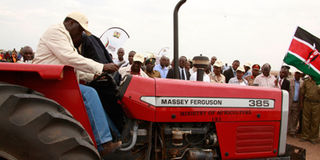Hola scheme gets first harvest in 20 years

President Mwai Kibaki flags off a tractor driven by Prime Minister Raila Odinga during the launch of the phase II field preparation process at Hola Irrigation Scheme, Tana River District, in August 2009. FILE
There was joy at the giant Hola Irrigation Scheme in Tana River at the weekend when the first maize crop harvest was launched after 20 years of inactivity.
Farmers will harvest about 2,200 tonnes of maize that will earn them more than Sh52 million, according to the scheme manager Mr Allex Wainaina Kuria.
“We have experienced the first harvest after more than 20 years of no work in the scheme. There is excitement among the 650 farmers, as others wait for the maturity of their crop in one or two weeks,” Mr Kuria said.
When the Nation team visited the scheme on Friday, it found the more than 1,200 hectares, which were bare soil three months ago, bubbling with green lush fields of maize crop. The area is raining heavily, but ploughing is still ongoing.
“This is like a miracle. For the last 20 or so years, we have never known a crop,” said a farmer, Mr Gibson Mwaura, who has stayed in the scheme since the 1980s.
The farmers urged the National Cereals and Produce Board (NCPB) to buy the grains from them promptly, to avoid losses due to aflatoxin.
“If NCPB does not buy our maize, all the work we have done will be useless because the maize will be destroyed by pests and aflatoxin,” said Mr Mwaura.
Mr Kuria added that 1,240 acres were under crops with each of the 650 farmers having two acres each that will be increased to four next year.
“We expect to harvest 2,200 tonnes of maize this season. Each acre produces 20 bags of a 90kg bag, so at the current price of Sh2,600 per bag, each farmer is expecting to earn Sh104,000,” said Mr Kuria.
Mr Kuria said the coastal climate allows three maize crop harvests annually, as the crop matures within three months unlike the up country areas of the country.
“We did not have major problems for this crop. Pests were well controlled, we had sufficient water supply and other factors were under control resulting in this bounty harvest,” he said.
However, the National Irrigation Board is worried by about aflatoxin, which is high in the high moisture atmosphere in the area.
Fully mature
“We have taken great caution on the aflatoxin. The crop will be harvested after it is fully mature and the moisture content is right. The grains will then be taken to a central place,” he said and insisted on the need for the grains to be purchased immediately after harvest by the NCPB.
His worries follow the discovery of aflatoxin in the neighbouring Bura Irrigation Scheme recently, which led to 90,000 bags of maize being declared unfit for human consumption.
The National Youth Service is expected to add 1,500 acres of crop from January next year, he said, adding that 30 varieties of maize are under research at the NIB laboratories.
“Crop diversification to include Soya beans, cow peas, green grams and others suitable in this climate will be planted in the near future,” said Mr Kuria.




